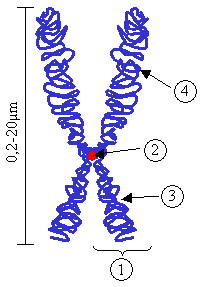A centromere may have a "turn-out" type structure, shown as:
Below is a view of a telomere, looking at the end of a section of DNA, essentially looking down the "cylinder" of the double helix of DNA. The helicity of DNA changes as a chromosome replicates itself, and it seems that this helicity is what is described in those right angle intersections shown above. Here is a view of a telomere, note the quadrature, or squaring of the structure:
Below is a view of a centromere, with a view of the entire chromosome. This illustration shows how four cylinder sections intersect at a right angle. Centromere is shown as feature 2.
A catalyst works by providing an alternative reaction pathway to the reaction product. The rate of the reaction is increased as this alternative route has a lower activation energy than the reaction route not mediated by the catalyst. The geometry described here is analogous to providing an alternative route with lower activation energy.
The centromere and telomere structure are similar to fullerene molecules in a few striking ways. The presence of hexagons and pentagons within the base sections is a feature the telomere shares with fullerenes. Cylinder and sphere sections are found in both centromes & telomeres and fullerenes. It is proposed that centromeres & telomeres create a lowering of thermodynamic or activation energy ‘threshold’: the same is true of fullerenes as evidenced by their existence in nature.
Currently the vast majority of genetic research is empirical, not theoretical. That is, functions of genomes are determined by seeing what effect manipulating (e.g. removing, etc.) a particular genome has on the design/function of the organism it describes. This approach disregards the geometry of DNA, and does not allow certain theoretical insights, which may otherwise be gained. Consideration of geometry may indicate thermodynamic ‘net gains’ that might point to functionality of chemical states.
Close examination of DNA geometry seems to have slowed immensely since Watson and Crick discovered the double helix. DNA is more than a ‘blueprint’; it is the blueprint, architect, engineer, construction worker and building inspector. It is more than these analogs; it is the actual thing itself. This appears to merit a close inspection of its structure and geometry in order to more fully understand it. If this theoretical (geometrical) approach is coupled with the knowledge gained from the empirical approach (i.e.- mapping of the human genome) then a much deeper level of understanding may be obtained.
A cell creates itself and closes itself off. It has genesis and distinction (becoming distinct, having a boundary within which it exists). This geometric model works for the combination of origin (sphere) and growth (cylinders). This is somewhat analogous to the thermodynamic conditions necessary for nucleation and growth in crystal formation. Duplication results in 2 spheres as distinct cells. The separation and distinction of 2 from 1 embodies or relates directly to the activation energy threshold.
We've had a look at one possible role of geometry, to try and show that geometry can play an important role in how things work. Enough of this detour though. Next time we'll start to look at some of the applications for this masonry system. Here it gets pretty interesting.






No comments:
Post a Comment